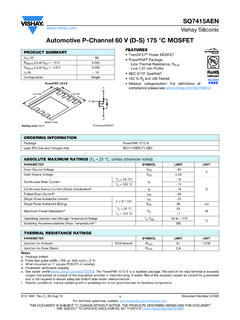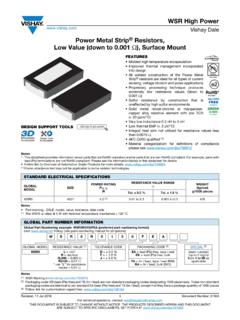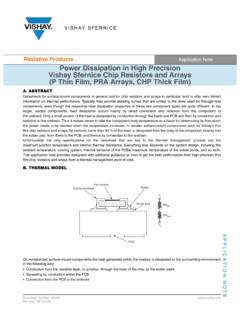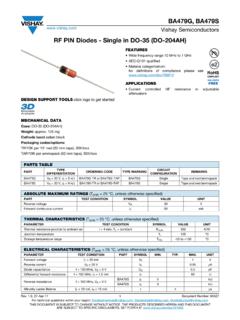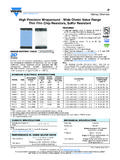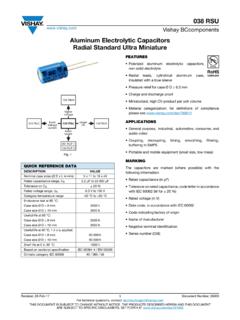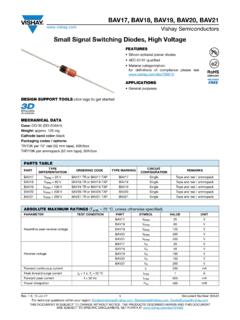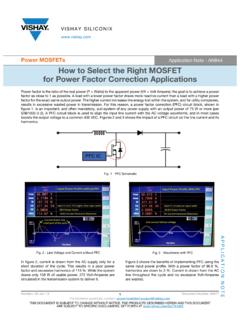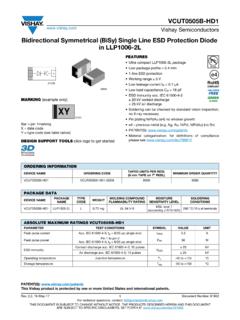Transcription of Pad Layouts/Soldering Process - Vishay
1 Pad Layouts/Soldering General Semiconductor Revision: 12-Sep-131 Document Number: 88854 For technical questions within your region: DOCUMENT IS SUBJECT TO CHANGE WITHOUT NOTICE. THE PRODUCTS DESCRIBED HEREIN AND THIS DOCUMENTARE SUBJECT TO SPECIFIC DISCLAIMERS, SET FORTH AT Layouts/Soldering ProcessVISHAY GENERAL SEMICONDUCTOR RECOMMENDED MINIMUM MOUNTING PAD layout SIZES FOR THE SURFACE MOUNT ( ) ( ) ( ) ( ) ( ) ( ) ( ) ( ) ( )DFS ( ) ( ) ( ) ( ) ( ) ( ) ( ) ( ) ( ) ( ) ( ) ( ) ( )TO-277A (SMPC) ( ) ( ) ( ) ( ) ( ) ( ) ( ) ( ) ( ) ( ) (GL34)/DO-213AB (GL-41)DO-220AA (SMP) ( ) ( ) ( ) ( ) ( ) All dimensions in inches (millimeters) ( ) ( ) ( ) ( ) (SMA)/DO-214BA (GF1)MBS ( ) ( ) ( ) ( ) ( )MBLS ( ) ( ) ( ) ( ) ( )
2 DO-214AA (SMB)DO-214AB (SMC)Pad Layouts/Soldering General Semiconductor Revision: 12-Sep-132 Document Number: 88854 For technical questions within your region: DOCUMENT IS SUBJECT TO CHANGE WITHOUT NOTICE. THE PRODUCTS DESCRIBED HEREIN AND THIS DOCUMENTARE SUBJECT TO SPECIFIC DISCLAIMERS, SET FORTH AT GENERAL SEMICONDUCTOR RECOMMENDED soldering PROCESST hrough hole device (THD) and surface mount device (SMD) imply different soldering technologies leading to different THD, the package body is exposed to relatively low temperatures (< 150 C) because the lead extremeties are only dipped in the soldering alloy, whereas in SMD the whole package body is exposed to a very high temperature (> 240 C)
3 During reflow soldering addition, molding compounds used for encapsulation absorb moisture from the ambient medium. During rapid heating in solder reflow Process ; this absorded moisture can vaporize, generating pressure at lead frame pad/silicon to plastic interfaces in the package, with a risk of package cracking and potential degradation of device soldering with SMD packages is not recommended because the thermal shock associated with package body solder dipping may induce internal structural damage to the package (interface delamination) that may affect long term package characterizations performed as a standard by Vishay only induce Solder Reflow Resistance JESD A111 recommends that wave soldering of SMD packages should be evaluated by the USER, because the stress induced inside the package is very dependant of solder Process to the higher melting point of lead (Pb)-free alloys, the temperature of the solder pot will also increase to improve solderability and shorten contact times.
4 For AgSnCu with melting point of 217 C, the solder pot temperature will be between 250 C to 270 C or as high as 260 C to 280 C for in inches (millimeters)DO-213AA(GL34)DO-213AB(GL41 ) ( ) ( ) ( ) ( ) ( ) ( ) ( ) ( ) ( ) ( ) ( ) ( ) ( ) (SlimSMA)DO-221BC (SMPA) ( ) ( ) MIN. ( ) MAX. ( ) ( ) ( ) ( ) ( ) ( ) ( ) REF.( )( ) ( ) ( ) ( ) (SMPD)Pad Layouts/Soldering General Semiconductor Revision: 12-Sep-133 Document Number: 88854 For technical questions within your region: DOCUMENT IS SUBJECT TO CHANGE WITHOUT NOTICE. THE PRODUCTS DESCRIBED HEREIN AND THIS DOCUMENTARE SUBJECT TO SPECIFIC DISCLAIMERS, SET FORTH AT WAVE soldering PROFILE FOR THROUGH HOLE COMPONENTS Fig.
5 1 Fig. 2 REFLOW FOR SURFACE MOUNTED COMPONENTSN otes(1)Tolerance for peak profile temperature (Tp) is defined as a supplier minimum and user maximum(2)Tolerance for time at peak profile temperature (Tp) is defined as a supplier minimum and user maximum Full line: typicalDotted line: Process limits050100150200250050100150200250300 Time (s)Temperature ( C)235 C ~ 260 C< 105 Cto 165 CSecond waveFirst wave- 5 C/s- 2 C/s+ 200 C/s+ 2 C/sForcedcooling10 sActivationof Flux100 C ~ 130 CPbT3T2T1270 C +/- 5 CTmelt 217 CPreheating 180 C 130 C min. First waveSecond wave6 C/s C/s min to 5 minNotes Temperature jump from T2 to T3 (w1): 150 C max.
6 Time from 25 C to T3 (wave temp.): 8 min (w1 + w2) 7 S+ 2- 0 Lead (Pb)-freeTemperature ( C)TABLE 1 - CLASSIFICATION REFLOW PROFILE PROFILE FEATURESn-Pb EUTECTIC ASSEMBLYLEAD (Pb)-FREE ASSEMBLYP reheat and soakTemperature min. (TSmin.)100 C150 CTemperature max. (TSmax.)150 C200 CTime (TSmin. to TSmax.) (tS)60 s to 120 s60 s to 120 sAverage ramp-up rate (TSmax. to Tp)3 C/s maximumLiquidous temperature (TL)183 C217 CTime to liquidous (tL)60 s to 150 s60 s to 150 sPeak package temperature (Tp) (1)See classification temperature in table 2 See classification temperature in table 3 Time (tp) (2) with 5 C of the specified classification temperature (TC)20 s (2)30 s (2)Average ramp-down rate (Tp to TSmax.)
7 6 C/s maximumTime 25 C to peak temperature6 min maximum8 min maximumPad Layouts/Soldering General Semiconductor Revision: 12-Sep-134 Document Number: 88854 For technical questions within your region: DOCUMENT IS SUBJECT TO CHANGE WITHOUT NOTICE. THE PRODUCTS DESCRIBED HEREIN AND THIS DOCUMENTARE SUBJECT TO SPECIFIC DISCLAIMERS, SET FORTH AT PROFILE Fig. 3 Tolerance: The device manufacturer/supplier shall assure Process compatibility up to and including the stated classification temperature at the rated MSL Package volume excludes external terminals (balls, bumps, lands, leads) and/or non-integral heatsinks.
8 The maximum component temperature reached during reflow depends on package thickness and volume. The use of convection reflow processes reduces the thermal gradients between packages. However, thermal gradients due to differences in thermal mass of SMD packages may still exist. Recommended soldering Process is accordance with 2 - Sn-Pb EUTECTIC Process PACKAGE PEAK REFLOW TEMPERATURESPACKAGE THICKNESSVOLUME mm3 < 350 VOLUME mm3 350< mm235 C220 C mm220 C220 CTABLE 3 - LEAD (Pb) - FREE Process PACKAGE CLASSIFICATION REFLOW TEMPERATURESPACKAGE THICKNESSVOLUME mm3 < 350 VOLUME mm3 350 TO 2000 VOLUME mm3 > 2000< mm260 C260 C260 mm to mm260 C250 C245 C mm250 C245 C245 CTimeTemperaturetSTime 25 C to AreaTC - 5 CMax.
9 Ramp Up Rate = 3 C/sMax. Ramp Down Rate = 6 C/sUser tPSupplier tPTC- 5 CTCS upplier TP TCUser TP TC
